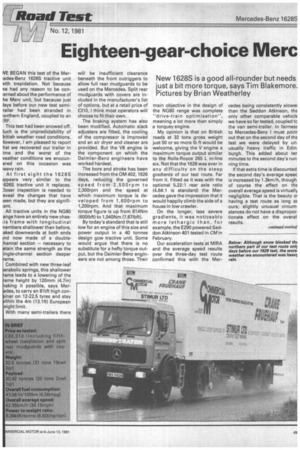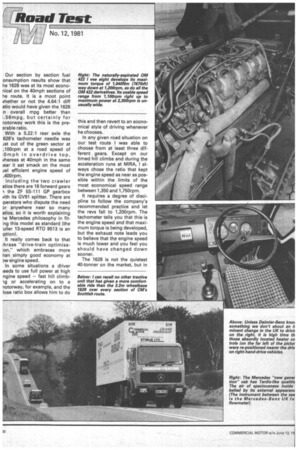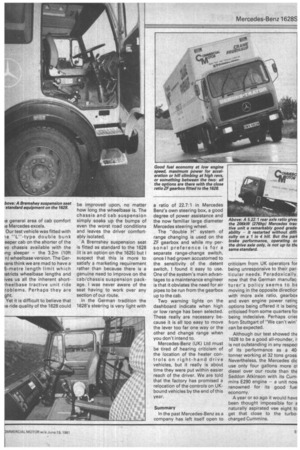Eighteen-gear-choice Mem
Page 51

Page 52

Page 53

If you've noticed an error in this article please click here to report it so we can fix it.
New 1628S is a good all-rounder but needs just a bit more torque, says Tim Blakemore. Pictures by Brian Weatherley
(1/E BEGAN this test of the Mer:edes-Benz 16285 tractive unit vith trepidation. Not because ye had any reason to be con:erned about the performance of he Merc unit, but because just Jays before our new test semirailer had been stranded in lorthern England, coupled to an ERF.
This test had been snowed off. iuch is the unpredictability of 3ritish weather road conditions. lowever, I am pleased to report hat we recovered our trailer in ime and the worst of the veather conditions we encounered on this occasion was leavy rain.
At first sight the 1 6 2 8S ippears very, similar to the 6265 tractive unit it replaces. :loser inspection is needed to eveal the changes that have }een made, but they are signifi:ant.
All tractive units in the NG80 ange have an entirely new chas:is frame with longitudinal nembers shallower than before, aked downwards at both ends Ind now made of a doublehannel section — necessary to tam n the same strength as the ingle-channel section deeper ame.
Combined with new three-leaf arabolic springs, this shallower ame leads to a lowering of the ame height by 120mm (4.7in) aking it possible, says Meredes, to carry an 81/2f1 high coniner on 12-22.5 tyres and stay ithin the 4m (13.1ft) European eight limit.
With many semi-trailers there will be insufficient clearance beneath the front outriggers to allow full rear mudguards to be used on the Mercedes. Split rear mudguards with covers are included in the manufacturer's list of options, but at a retail price of £310, I think most operators will choose to fit their own.
The braking system has also been modified. Automatic slack adjusters are fitted, the cooling of the compressor is improved and an air dryer and cleaner are provided. But the V8 engine is the component on which the Daimler-Benz engineers have worked hardest.
The bore and stroke has been increased from the OM 402, 1626 days, reducing the governed speed from 2,5 0 °rpm to 2,300rpm and the speed at which maximum torque is developed from 1,600rpm to 1,200rpm. And that maximum torque figure is up from 814Nm (600Ibft) to 1,040Nm (7,67Ibft).
By today's standard that is still low for an engine of this size and power output in a 40 tonnes design gcw tractive unit. Some would argue that there is no substitute for a hefty torque output, but the Daimler-Benz engineers are not among those. Their main objective in the design of the NG80 range was complete "drive-train optimisation", meaning a lot more than simply a torquey engine.
My opinion is that on British roads at 32 tons gross weight just 50 or so more lb ft would be welcome, giving the V engine a maximum torque output similar to the Rolls-Royce 265 L in-line six. Not that the 1628 was ever in any difficulty on the steep gradients of our test route. Far from it. Fitted as it was with the optional 5.22:1 rear axle ratio (4.64:1 is standard) the Mercedes gave the impression that it would happily climb the side of a house in low crawler.
On the longer, less severe gradients, it was noticeably more lethargic than, for example, the E290 powered Seddon Atkinson 401 tested in CM in February.
Our acceleration tests at MIRA and the average speed results over the three-day test route confirmed this with the Mer
cedes being consistently slower than the Seddon Atkinson, thc only other comparable vehicic we have so far tested, coupled tc the van semi-trailer. In fairnesE to Mercedes-Benz I must poin1 out that on the second day of thE test we were delayed by un• usually heavy traffic in Edin• burgh. This added about ter minutes to the second day's run• ning time.
If that extra time is discounted the second day's average speec is increased by 1.3km/h, though, of course the effect on thE overall average speed is virtually negligible. That is the beauty o1 having a test route as long w ours; slightly unusual circumstances do not have a dispropor. tionate effect on the overal results.
Our section by section fuel onsurnption results show that he 1628 was at its most econonical on the 40mph sections of he route. It is a moot point vhether or not the 4.64:1 diff atio would have given the 1628 n overall mpg better than ,.56mpg, but certainly for notorway work this is the prearable ratio.
With a 5.22:1 rear axle the 628's tachometer needle was ist out of the green sector at ,10Orpm at a road speed of 0rnph in overdrive top, vhereas at 40mph in the same lea!' it sat smack on the most Jel efficient engine speed of ,40Orpm.
Including the two crawler atios there are 18 forward gears -1 the ZF 5S-111 GP gearbox vith its GV91 splitter. There are ■ perators who dispute the need Dr anywhere near so many atios, so it is worth explaining le Mercedes philosophy in fitrig this model as standard (the uller 13-speed RTO 9513 is an ,ption).
It really comes back to that ihrase "drive-train optimisaion," which embraces more han simply good economy at wit engine speed.
In some situations a driver reeds to use full power at high ngine speed — fast hill climbng or accelerating on to a rtotorway, for example, and the lose ratio box allows him to do Right: The naturally-aspirated OM 422 1 wee eight develops its maximum torque of 1,040Nm (7671bft) way down at 1200rpm, as do all the OM 422 derivatives. Its usable speed range from 1,100rpm right up to maximum power at 2,300rpm is unusually wide.
this and then revert to an economical style of driving whenever he chooses.
In any given road situation on our test route I was able to choose from at least three different gears. Except on our timed hill climbs and during the acceleration runs at MIRA, I always chose the ratio that kept the engine speed as near as possible within the limits of the most economical speed range between 1,350 and 1,750rpm.
It requires a degree of discipline to follow the company's recommended practice and let the revs fall to 1,200rpm. The tachometer tells you that this is the engine speed and that maximum torque is being developed, but the exhaust note leads you to believe that the engine speed is much lower and you feel you should have changed down sooner.
The 1628 is not the quietest 40-tonner on the market, but in le general area of cab comfort le Mercedes excels.
Our test vehicle was fitted with
"L"-type double bunk eeper cab on the shorter of the vo chassis available with the ing sleeper — the 3.2m (10ft n) wheelbase version. The Gertans think we are mad to have a 5-metre length limit which ;stricts wheelbase lengths and ives us all the inherent short,heelbase tractive unit ride roblems. Perhaps they are ght.
Yet it is difficult to believe that le ride quality of the 1628 could be improved upon, no matter how long the wheelbase is. The chassis and cab suspension simply soaks up the bumps of even the worst road conditions and leaves the driver comfortably isolated.
A Bremshey suspension seat is fitted as standard to the 1628 (it is an option on the 1625} but I suspect that this is more to satisfy a marketing requirement rather than because there is a genuine need to improve on the cab/chassis suspension package. I was never aware of the seat having to work over any section of our route.
In the German tradition the 1628's steering is very fight with a ratio of 22.7:1 in Mercedes Benz's own steering box, a good degree of power assistance and the now familiar large diameter Mercedes steering wheel.
The "double H" system of range changing is used on the ZF gearbox and while my personal preference is for a separate range-change switch, once I had grown accustomed to the sensitivity of the detent switch, I found it easy to use. One of the system's main advantages to a maintenance engineer is that it obviates the need for air pipes to be run from the gearbox up to the cab.
Two warning lights on the dashboard indicate when high or low range has been selected. These really are necessary because it is all too easy to move the lever too far one way or the other and change range when you don't intend to.
Mercedes-Benz (UK) Ltd must be tired of hearing criticism of the location of the heater controls on right-hand drive vehicles, but it really is about time they were put within easier reach of the driver. We are told that the factory has promised a relocation of the controls on UKbound vehicles by the end of this year.
Summary In the past Mercedes-Benz as a company has left itself open to criticism from UK operators for being unresponsive to their particular needs. Paradoxically, now that the German manufacturer's policy seems to be moving in the opposite directior with more axle ratio, gearbox and even engine power rating options being offered it is being criticised from some quarters fot being indecisive. Perhaps cries from Stuttgart of "We can't win' can be expected.
Although our test showed thE 1628 to be a good all-rounder, ii is not outstanding in any respecl of its performance as a 40tenner working at 32 tons gross. Nevertheless, the Mercedes dic use only four gallons more oi diesel over our route than the Seddon Atkinson with its Cummins 5290 engine — a unit no renowned for its good fuel economy.
A year OF so ago it would have been thought impossible for a naturally aspirated vee eight to get that close to the turbocharged Cummins.












































































































































